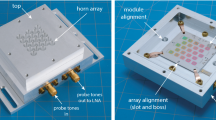Abstract
In this paper we report on the design and validation process for the profiled corrugated horn antennas, which feed the bolometer array of a cosmology experiment known as QUaD located at the South Pole. This is a cosmic background radiation polarization project, which demands precise knowledge and control of the optical coupling to the signal in order to map the feeble E- and B-polarization mode structure. The system will operate in two millimeter wavelength bands at 100 and 150 GHz. The imaging horn array collects the incoming signal via on-axis front-end optics and a Cassegrain telescope, with a cold stop in front of the array to terminate side-lobe structure at an edge taper of −20dB. The corrugated horn design process was undertaken using in-house analytical software tools, based on modal scattering, specially developed for millimeter -wave profiled horn antennas. An important part of the instrument development was the validation of the horn design, in particular to verify low edge taper levels and the required well-defined band edges. Suitable feed horn designs were measured and were found to be in excellent agreement with theoretical predictions.
Similar content being viewed by others
References
[1] B. Maffei et al., “Shaped corrugated horns for Cosmic Microwave Background anisotropy measurements”, Int. J. Infrared & Millimeter Waves, 21, 2023, 2000
[2] R. Colgan, Electromagnetic and Quasi-optical Modelling of Horn Antennas for Far-IR Space Applications, Ph.D. thesis, NUI Maynooth 2001
[3] J.A. Murphy et al., “Radiation patterns of multi-moded corrugated horns for far-IR space applications”, Infrared Physics and Technology, 42, 515, 2001
[4] S. Church et al., “QUEST and DASI: A South-Pole CMB polarization experiment”, New Astron. Revs., 47, 1083–1089, 2003
[5] J.M. Lamarre, et al., “The High Frequency Instrument on PLANCK: Design and Performance”, Astro. Letters and Communications, 37, 161–170, 2000
[6] E. Gleeson et al., “Definition of the Multi-Mode Horns for the HFI Instrument on PLANCK”, Proceedings of 25th ESA Antenna Workshop on Satellite Antenna Technology, 609–615, ESTEC, Noordwijk, 2002.
[7] A. D. Olver et al., Microwave Horns and Feeds, chapter 4, IEEE Press, New York, 1994.
[8] A. Rusholme et al., “QUaD: A ground based millimeter-wave telescope for CMB polarization studies”, Carnegie Observatories Astrophysics Series, Measuring and Modeling the Universe, (ed. W. L. Freedman), 2, 2003
[9] L. Piccirillo et al., “QUaD-A 2.6-m mm-Wave Telescope for CMB Polarization Studies”, Astrophysical Polarized Backgrounds AIP Conference Proceedings, p159, 609, 2002
[10] G. Cahill et al., “The Quasi-Optical Design of the QUaD Telescope”, Proceedings of the SPIE International Conference on Astronomical Instrumentation, Glasgow, 2004
[11] E.M. Leitch et al., “Measurement of Polarization with the Degree Angular Scale Interferometer”, Nature, 420, pp. 763–771, 2002
[12] A. Kogut et al., “First Year Wilkinson Microwave Anisotropy Probe (WMAP) Observations: Temperature-Polarization Correlation”, Astrophysical Journal Supplement Series, 148, pp. 161, 2003
[13] A.C.S. Readhead et al. “Polarization Observations with the Cosmic Background Imager” astro-ph/0409569
[14] M. Bowden et al., “Scientific optimization of a ground-based CMB polarization experiment”, Monthly Notices of the Royal Astronomy Society, 349, 321–335,2004
[15] W.C. Jones et al., “A Polarization Sensitive Bolometric Receiver for Observations of the Cosmic Microwave Background”, in Millimeter and Submillimeter Detectors for Astronomy, Phillips T. G. & Zmuidzinas J., eds., Proceedings of the SPIE, 4855, 227, 2003
[16] J.J. Bock, “Bolometers for Millimeter-wave Cosmology”, Proceedings of the 2K1BC Workshop on Experimental Cosmology at Millimeter Wavelengths, Breuil Cervinia, Italy, July 2001
[17] P.A.R. Ade et al., “Filters, Dichroics, Beam Dividers and Fabry-Perot Plates for Ultra-low-background Far Infrared Instruments”, Proceedings of the Second Workshop on New Concepts for Far-IR Submillimeter Space Astronomy, University of Maryland, 2002
[18] Clarricoats P.J.B. and Olver A.D., Corrugated Horns for Microwave Antennas, chapter 3, Peter Peregrinus, 1984.Clarricoats
[19] E. Gleeson et al., “Corrugated Waveguide Band Edge Filters for CMB Experiments in the Far Infrared,” Infrared Physics and Technology, (in press).
[20] E. Gleeson et al., “‘Phase centres’ of Far Infrared Multi-moded Horn Antennas”, Int. J. Infrared & Millimeter Waves, 23, No. 5, 711 – 730, 2002.
Author information
Authors and Affiliations
Rights and permissions
About this article
Cite this article
Murphy, J., Gleeson, E., Cahill, G. et al. Millimeter-Wave Profiled Corrugated Horns for the Quad Cosmic Background Polarization Experiment. Int J Infrared Milli Waves 26, 505–523 (2005). https://doi.org/10.1007/s10762-005-4069-7
Received:
Published:
Issue Date:
DOI: https://doi.org/10.1007/s10762-005-4069-7




